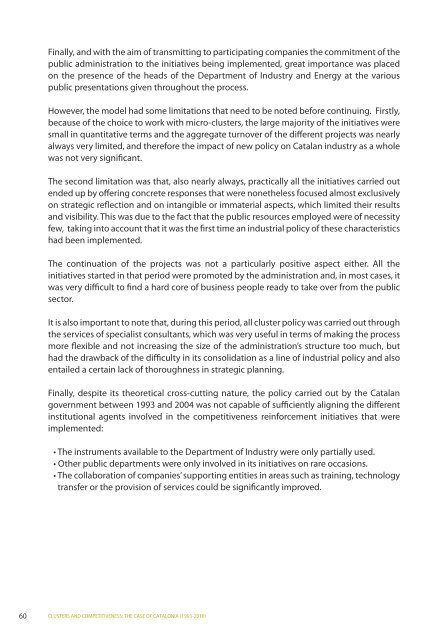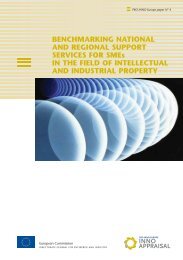Clusters and competitiveness - PRO INNO Europe
Clusters and competitiveness - PRO INNO Europe
Clusters and competitiveness - PRO INNO Europe
You also want an ePaper? Increase the reach of your titles
YUMPU automatically turns print PDFs into web optimized ePapers that Google loves.
Finally, <strong>and</strong> with the aim of transmitting to participating companies the commitment of the<br />
public administration to the initiatives being implemented, great importance was placed<br />
on the presence of the heads of the Department of Industry <strong>and</strong> Energy at the various<br />
public presentations given throughout the process.<br />
However, the model had some limitations that need to be noted before continuing. Firstly,<br />
because of the choice to work with micro-clusters, the large majority of the initiatives were<br />
small in quantitative terms <strong>and</strong> the aggregate turnover of the different projects was nearly<br />
always very limited, <strong>and</strong> therefore the impact of new policy on Catalan industry as a whole<br />
was not very significant.<br />
The second limitation was that, also nearly always, practically all the initiatives carried out<br />
ended up by offering concrete responses that were nonetheless focused almost exclusively<br />
on strategic reflection <strong>and</strong> on intangible or immaterial aspects, which limited their results<br />
<strong>and</strong> visibility. This was due to the fact that the public resources employed were of necessity<br />
few, taking into account that it was the first time an industrial policy of these characteristics<br />
had been implemented.<br />
The continuation of the projects was not a particularly positive aspect either. All the<br />
initiatives started in that period were promoted by the administration <strong>and</strong>, in most cases, it<br />
was very difficult to find a hard core of business people ready to take over from the public<br />
sector.<br />
It is also important to note that, during this period, all cluster policy was carried out through<br />
the services of specialist consultants, which was very useful in terms of making the process<br />
more flexible <strong>and</strong> not increasing the size of the administration’s structure too much, but<br />
had the drawback of the difficulty in its consolidation as a line of industrial policy <strong>and</strong> also<br />
entailed a certain lack of thoroughness in strategic planning.<br />
Finally, despite its theoretical cross-cutting nature, the policy carried out by the Catalan<br />
government between 1993 <strong>and</strong> 2004 was not capable of sufficiently aligning the different<br />
institutional agents involved in the <strong>competitiveness</strong> reinforcement initiatives that were<br />
implemented:<br />
• The instruments available to the Department of Industry were only partially used.<br />
• Other public departments were only involved in its initiatives on rare occasions.<br />
• The collaboration of companies’supporting entities in areas such as training, technology<br />
transfer or the provision of services could be significantly improved.<br />
60 CLUSTERS AND COMPETITIVENESS: THE CASE OF CATALONIA (1993-2010)
















